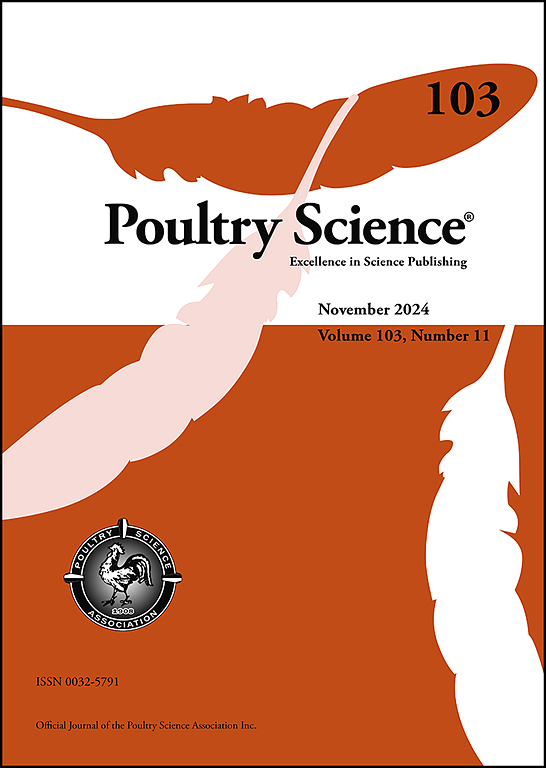Epidemiological characteristics of infectious bursal disease virus (IBDV) in China from 2023 to 2024: Mutated very virulent IBDV (mvvIBDV) is associated with atypical IBD
IF 3.8
1区 农林科学
Q1 AGRICULTURE, DAIRY & ANIMAL SCIENCE
引用次数: 0
Abstract
Infectious bursal disease (IBD), caused by the infectious bursal disease virus (IBDV), threatens the global poultry industry with acute immunosuppression. The non-lethal novel variant IBDV (nVarIBDV) has been identified as the primary cause of a new outbreak of atypical IBD in China. However, since 2023, several poultry farms in China have continuously reported the detection of vvIBDV in chicken flocks exhibiting atypical IBD characteristics. To analyze this abnormal problem, the prevalence of IBDV in major poultry farming areas in China from 2023 to 2024 was monitored. Our epidemiological survey revealed four coexisting IBDV strains in China, nVarIBDV (69.9 %, 65/93) ranked the first, followed by vvIBDV (16.1 %, 15/93), attIBDV (8.6 %, 8/93), and cIBDV (5.4 %, 5/93). Notably, all these 15 vvIBDV strains detected in this study harbored single or combination mutations in the VP2 hypervariable region (HVR) including residue 279: D279N (seven strains), G254D/I256L/D279N (one strain), or A222T/G254D/I256L/D279N (seven strains). Furthermore, one representative strain of IBDV-NMG23-1701 which contained the D279N mutation was isolated. In the phylogenetic tree constructed based on the IBDV genome, IBDV-NMG23-1701 was located in the vvIBDV branch. However, IBDV-NMG23-1701 did not kill chickens directly but induced severe subclinical symptoms of atypical IBD. We named these strains mutated vvIBDV (mvvIBDV), which genotypically belonged to vvIBDV but exhibited atypical IBD symptoms. The mvvIBDV has been detected in several major poultry farming areas in China. This is the first study to identify mvvIBDV as a new pathogen causing atypical IBD, providing a scientific basis for optimizing prevention and control strategies.
2023 - 2024年中国传染性法氏囊病病毒(IBDV)流行病学特征:突变型强毒IBDV (mvvIBDV)与非典型IBD相关
由传染性法氏囊病病毒(IBDV)引起的传染性法氏囊病(IBD)以急性免疫抑制威胁着全球家禽业。非致死性新型IBDV (nVarIBDV)已被确定为中国非典型IBD新暴发的主要原因。然而,自2023年以来,中国的几个家禽养殖场不断报告在具有非典型IBD特征的鸡群中检测到vvIBDV。为分析这一异常问题,对2023 - 2024年中国主要家禽养殖区IBDV的流行情况进行了监测。流行病学调查显示,中国共有4株IBDV共存,其中nVarIBDV(69.9%, 65/93)居首位,其次是vvIBDV(16.1%, 15/93)、attIBDV(8.6%, 8/93)和cIBDV(5.4%, 5/93)。值得注意的是,本研究检测到的15株vvIBDV在VP2高变区(HVR)均存在单个或组合突变,包括残基279:D279N(7株)、G254D/I256L/D279N(1株)或A222T/G254D/I256L/D279N(7株)。此外,还分离到1株具有代表性的IBDV-NMG23-1701,其中含有D279N突变。在基于IBDV基因组构建的系统发育树中,IBDV- nmg23 -1701位于vvIBDV分支。然而,IBDV-NMG23-1701对鸡没有直接杀伤作用,但可引起严重的非典型IBD亚临床症状。我们将这些菌株命名为突变vvIBDV (mvvIBDV),它们的基因典型属于vvIBDV,但表现出非典型的IBD症状。在中国的几个主要家禽养殖区发现了mvvIBDV。本研究首次确定mvvIBDV为引起非典型IBD的新病原体,为优化防控策略提供科学依据。
本文章由计算机程序翻译,如有差异,请以英文原文为准。
求助全文
约1分钟内获得全文
求助全文
来源期刊

Poultry Science
农林科学-奶制品与动物科学
CiteScore
7.60
自引率
15.90%
发文量
0
审稿时长
94 days
期刊介绍:
First self-published in 1921, Poultry Science is an internationally renowned monthly journal, known as the authoritative source for a broad range of poultry information and high-caliber research. The journal plays a pivotal role in the dissemination of preeminent poultry-related knowledge across all disciplines. As of January 2020, Poultry Science will become an Open Access journal with no subscription charges, meaning authors who publish here can make their research immediately, permanently, and freely accessible worldwide while retaining copyright to their work. Papers submitted for publication after October 1, 2019 will be published as Open Access papers.
An international journal, Poultry Science publishes original papers, research notes, symposium papers, and reviews of basic science as applied to poultry. This authoritative source of poultry information is consistently ranked by ISI Impact Factor as one of the top 10 agriculture, dairy and animal science journals to deliver high-caliber research. Currently it is the highest-ranked (by Impact Factor and Eigenfactor) journal dedicated to publishing poultry research. Subject areas include breeding, genetics, education, production, management, environment, health, behavior, welfare, immunology, molecular biology, metabolism, nutrition, physiology, reproduction, processing, and products.
 求助内容:
求助内容: 应助结果提醒方式:
应助结果提醒方式:


